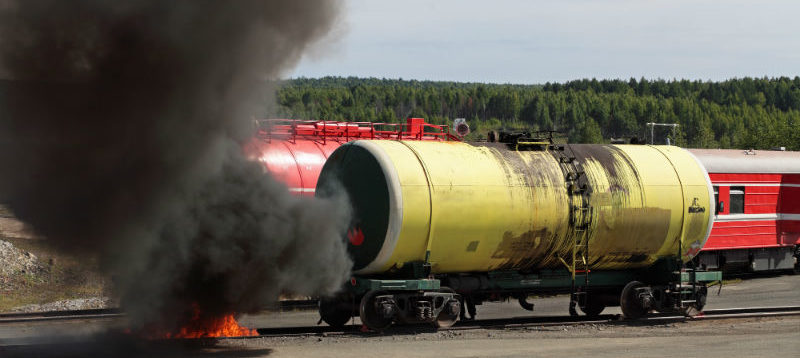Oil spilled into waterways and our communities, dangerous explosions and fire, and toxic smoke spewed into the air for miles are just a few of the reasons to stop transporting oil by train. Here’s another reason: even the fire response requires the use of dangerous chemicals that can contaminate our communities for decades.
When an oil train derails, there’s often a fire. Extinguishing the burning oil involves the use of firefighting foam. While we don’t know the exact chemical composition of the foams, and they vary, we know they contain precursor PFAS chemicals that can be transformed in the environment to perfluorinated chemicals, which are a serious concern for groundwater. These chemicals are members of the same family as the ones used to make stain-resistant coatings—chemicals that scientists have strongly cautioned against due to their high toxicity, high persistence, and ability to build up in the food chain.
PFAS chemicals stay in the environment for long periods of time, and can migrate into soil, groundwater, and eventually sources of drinking water. PFAS chemicals from firefighting foam already contaminate drinking water wells around the country, including here in Washington state.
In 2015, residents of Issaquah, WA discovered that one of their drinking water wells contained high levels of PFAS chemicals. Experts believe the use of firefighting foam on an oil tanker fire on Interstate 90 just east of Issaquah in 2002 may be the cause of the contamination. The city has shut down the well.
To make matters worse, the foams can’t even be used as a first line of defense on hot oil fires. The recent oil train derailment and subsequent explosions and fire along the Columbia River Gorge released an estimated 42,000 gallons of Bakken crude oil – a particularly hazardous type of oil –into the Columbia River, local sewer system, and surrounding soil. The huge black plumes of toxic smoke billowing from the overturned train cars created serious health risks for residents, prompting government officials to evacuate surrounding neighborhoods and issue an air advisory.
But because the superheated wreckage evaporated the foam before it had any effect on the fire, fire crews on the main Columbia River fire waited until 8-10 hours post-derailment to begin applying it, after the fire had cooled down enough for the foam to reach the burning fuel. So residents were exposed to toxic smoke for hours, and after that had more toxic chemicals dumped in their community, compounding an already toxic disaster.
After responding to the derailment and seeing the damage caused in his community, Fire Chief Jim Appleton of Mosier, Oregon said, “I hope that this becomes [the] death knell for this mode of shipping this cargo. I think it’s insane.”
We agree. It’s time to stop shipping oil through our communities.




